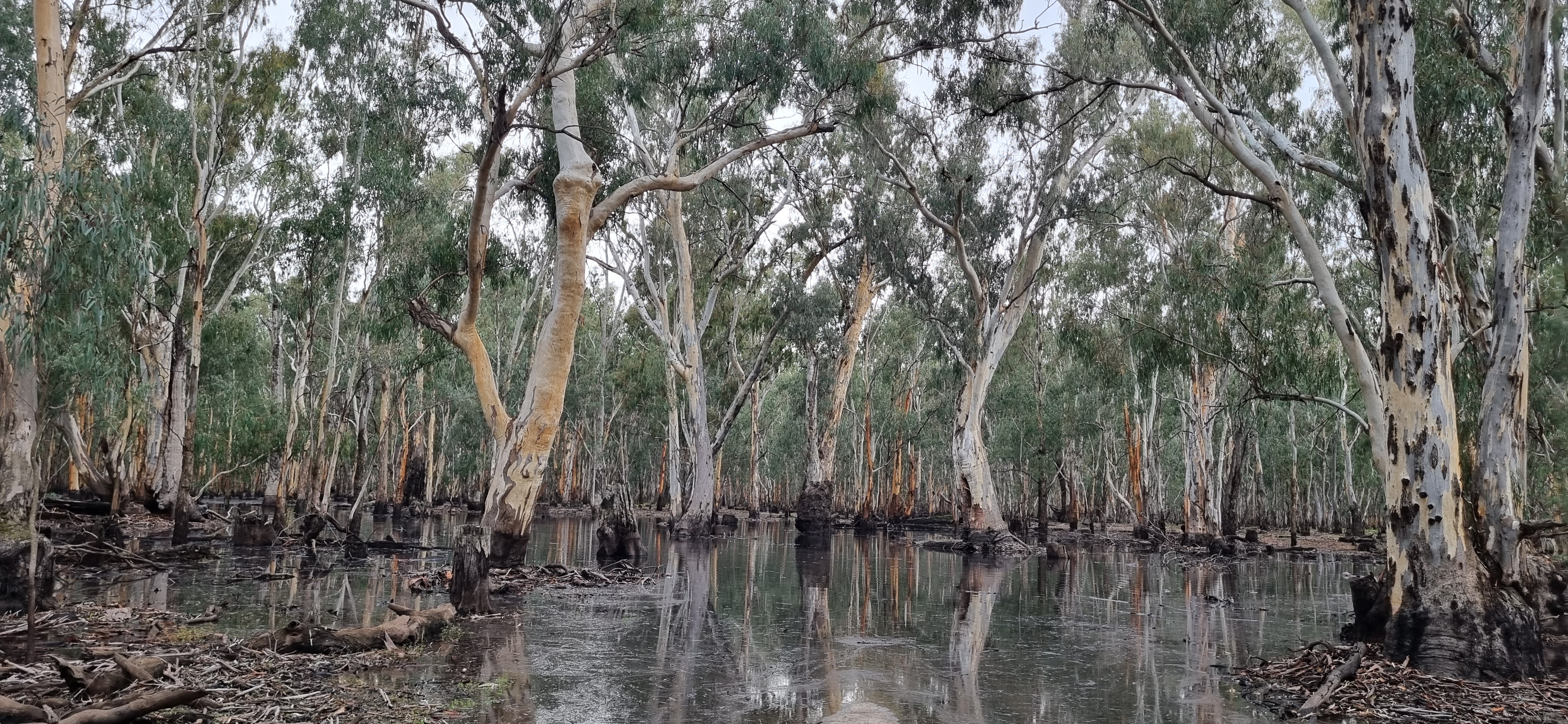Water for the environment played an important supporting role in northern Victoria last year, even after one of the biggest floods on record.
One example is Gunbower Forest, an internationally significant site under the Ramsar Convention that also forms part of the Living Murray Gunbower-Koondrook-Perricoota Forests’ icon site.
Bounded by the Murray River to the north and Gunbower Creek to the south, Gunbower Forest contains diverse and rare wetland habitats, including a large area of flood-dependent forest and species-rich floodplain wetlands. These habitats support internationally recognised migratory waterbirds, along with vulnerable and endangered plants and animals including river swamp wallaby-grass, wavy marshwort, winged peppercress, great egrets, white bellied sea eagles and musk ducks.

Image: Gunbower Creek and Forest, by North Central CMA
Environmental flows before the 2022 flood
Before the floods, water managers were completing their scheduled environmental watering actions for the latter half of 2022. An environmental flow was delivered to Gunbower Forest in winter through to early spring 2022, mimicking pre-regulation winter flows and helping prime the forest, start the breakdown of carbon on the floodplain while conditions were cool, and start to flush carbon off the floodplain in cooler weather when the risk of low dissolved oxygen is low.
Once natural events were pushing river levels higher in spring, deliveries of water for the environment were stopped and natural flooding took over.
Floodplain inundation triggers bird breeding events at Gunbower
The combination of water held for the environment and large unregulated inflows in spring provided the largest amount of wetland and fringing floodplain habitat for waterbird breeding and feeding since 1993-94. An estimated 70-80 per cent of the Gunbower Forest floodplain was inundated, significantly more than the 23 per cent that can be inundated with water for the environment deliveries alone.
The flood triggered significant waterbird breeding and gave the Gunbower Forest floodplain vegetation a much-needed drink. Waterbird numbers are in serious decline across the Murray-Darling Basin, and although waterbird abundance in 2022 increased compared with 2021, it is still below the long-term average1.
During the floods, more than 1000 juvenile waterbirds were recorded in Gunbower Forest. A number of large breeding events were seen across the Murray-Darling Basin on the back of the floods and supporting a diversity of breeding locations across the Basin helps spread the risk of breeding failure – not putting all our eggs in one basket!
Environmental flows after the floods
But these youngsters need habitat and food to survive to breeding age. CSIRO research2 in the Murray-Darling Basin has shown just how vulnerable young birds are to starvation, predation, and habitat loss, with low juvenile survival rates meaning that waterbird numbers haven’t improved long term, despite previous large breeding events. To survive to adulthood, they need healthy wetland and floodplain vegetation, and for the vegetation of Gunbower Forest to stay healthy it needs regular flooding. Maintaining the health of floodplain forests beyond one seasonal event is vital to support chicks to survive to breeding age themselves, with wetland areas providing foraging grounds and habitat.
The forest within the flood footprint where water for the environment deliveries can occur has experienced seven flood years over the past 20 years - this is only slightly more than half of the flooding frequency required to support the river red gum floodplain3. We know from monitoring after the 2010-11 floods how quickly the condition of trees, wetland and understorey vegetation deteriorated as the forest dried out. This is not surprising given the forest communities evolved with a very different pre-regulation regime of flooding.
The Gunbower Forest river red gums are still recovering from the effects of the Millennium Drought, and while the flooding in 2022 led to increased canopy health, it was preceded by three dry years in a row where annual monitoring showed a decline in tree condition.
A high wetting frequency is required to maximise the river red gums’ chance of recovery. Environmental flows started in June 2023 to support Gunbower Forest vegetation in between natural flow events, in turn providing appropriate habitat variation and food resources for young waterbirds and their parents.
Flexible, responsive environmental water management is an important tool the VEWH uses to maximise environmental outcomes in varying seasonal conditions. Here, we can see how water for the environment can be used to support outcomes in a wet seasonal scenario and the importance of deliveries over multiple years to achieve long-term outcomes after natural floods, such as improved vegetation condition and increased waterbird populations. Plants and animals have evolved to respond to Australia’s notoriously variable river systems; but river regulation has reduced the resilience of floodplain ecosystems like Gunbower Forest. With dry conditions forecast for the coming year, we will continue to work with our partners to support this very special place.